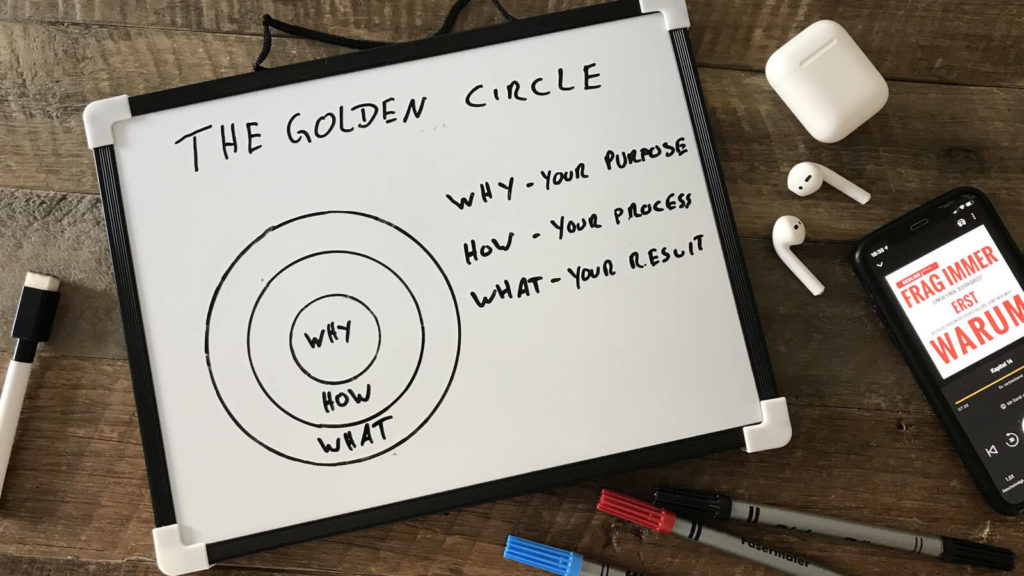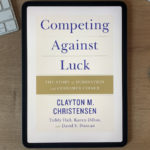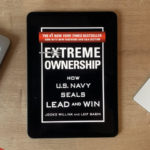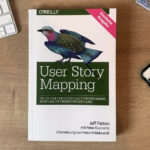
The golden circle – Put the WHY in the foreground
Communicate from the WHY to the HOW to the WHAT
Some time ago I saw a TEDx Talk about the Golden Circle on Youtube. In it, someone introduced the concept of “The Golden Circle”. In his talk, he put forward the thesis that most companies communicate from the outside in. However, very successful companies communicate in the opposite direction, from the inside to the outside. It is exactly the opposite direction that makes these companies so successful in their marketing. The speaker was Simon Sinek, he is considered the discoverer of the Golden Circle concept. I found the talk very inspiring, so I immediately downloaded the matching audiobook – “Start With Why” – from Audible. As a product manager or product owner, the Golden Circle concept can help you communicate with your stakeholders and the users of your product. I have embedded the Youtube video below.
This is how most people and companies communicate:
Most people and companies communicate from the outside in. That means they start by explaining WHAT they do, and only at the end WHY they do something specific. Recently, I was at a birthday party where I was talking to a car salesman. The conversation started with us talking about our professions. The vehicle salesman started by saying that he sells cars at a dealership. He then explained to me HOW he does it. “I approach customers on the sales floor of the dealership. I explain the details of the car and take the customer for a test drive. For some customers, I then have a contract drawn up.” In very few cases, however, is WHY someone does something described. The WHY is sometimes a difficult question to answer, so it is often simply left out. In my example, the person could have said that he might simply be interested in selling his customers a safer vehicle than they already own.
This is how successful people and companies communicate:
In the TEDx Talk, Simon Sinek explains the approach of successful companies using Apple as an example. Apple is one of the most valuable companies on the stock market, which is a clear indicator of success.
I’ll try it on the new Apple Watch campaign that was launched a few days ago. I think you can see the concept very well in the commercials. I have included the Apple Watch spot below.
The spot starts with the phrase, “Reach your sleep goals”. Here, the WHY is stated right at the beginning. WHY do you need an Apple Watch Series 6? So that you can achieve your sleep goals, such as sleeping 8 hours at a time.
This is followed by HOW in the spot. Apple gives a brief guide on HOW to achieve your sleep goals. The following three sentences “Step 1 – Fall asleep,” “Step 2 – Wake up,” and “The future of health. On your wrist” are displayed one after another. The HOW question was explained very simply. Wear the Apple Watch on your wrist while you sleep, and the watch will do the rest for you. As the owner of the new Apple Watch, you don’t have to worry about anything else.
The WHAT is only officially communicated very late at the end, in which Apple simply displays the “Apple Watch Series 6” for a second.
If you want to become successful as a product owner or as a product manager, you should also follow the Golden Circle.
How to use the Golden Circle in product management
Just use the Golden Circle during all your internal and external communication. In my daily emails and appointment invitations, I start directly with the reason for my email or appointment invitation.
An example would be: “Hello Matilde, we have registered an unusual user behavior. In this appointment, I want to talk to you about the potential cause of the user behavior and work out a solution on the whiteboard so we can set up an A/B test.
I started with my WHY: noticeable user behavior. Then I moved on to the HOW – identifying the cause and working out a solution. Finally, I presented the WHAT again – setting up an A/B test. Through this communication, I was able to help my colleagues better prepare for appointments and work out potential solutions and ask questions beforehand.
I also use the Golden Circle concept in the user approach of my products, as I have been able to demonstrably generate better success through this. One example is the labeling of buttons. Here I make sure that the button answers the WHY and directly mentions a solution for the customer problem that I want to solve with my product.
My conclusion on the Golden Circle in product management
I also use the concept of the Golden Circle when creating and presenting the product roadmap or when including product requests in my backlog. With the topics for the roadmap or the backlog, I always answer the question of the WHY first, because only then can I myself stand behind a topic that the developers in my team are implementing. If I cannot answer the question of the WHY myself, I simply ask the question to my stakeholder who has approached me about the topic.



